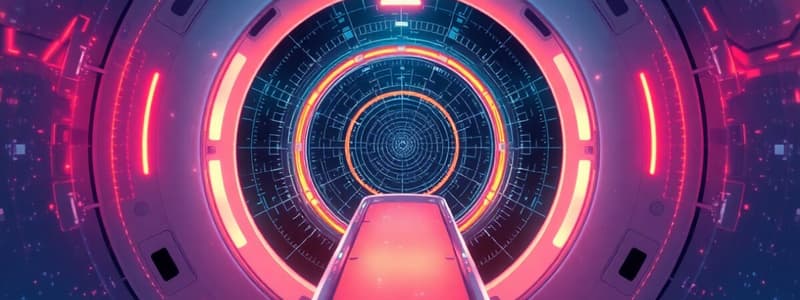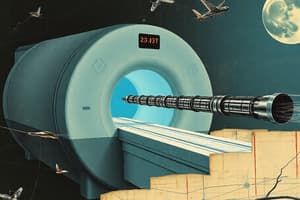Podcast
Questions and Answers
What is the primary purpose of using liquid helium in MRI machines?
What is the primary purpose of using liquid helium in MRI machines?
- To create the magnetic field
- To maintain superconductivity in the magnet (correct)
- To cool the outer vacuum case
- To generate an electrical current
Which temperature is typical for the operating condition of the superconducting coil in MRI machines?
Which temperature is typical for the operating condition of the superconducting coil in MRI machines?
- 0 K
- 269.1 K
- 40 K
- 4 K (correct)
What is a key feature of recent advancements in MRI cooling systems?
What is a key feature of recent advancements in MRI cooling systems?
- Use of liquid nitrogen only
- Incorporation of a cryocooler for radiation shields (correct)
- Elimination of the need for liquid helium
- Reduction of the magnet size
How much liquid helium is typically required for a standard MRI scanner?
How much liquid helium is typically required for a standard MRI scanner?
What happens during the 'ramp up' process of the MRI magnet?
What happens during the 'ramp up' process of the MRI magnet?
What is the purpose of the outer vacuum case (OVC) in the cryostat of an MRI?
What is the purpose of the outer vacuum case (OVC) in the cryostat of an MRI?
What determines the minimum allowable liquid helium volume in an MRI machine?
What determines the minimum allowable liquid helium volume in an MRI machine?
What is a common issue that needs to be addressed during the normal operating conditions of an MRI machine?
What is a common issue that needs to be addressed during the normal operating conditions of an MRI machine?
What is the primary benefit of the dual-stage cryocooler in the cooling process?
What is the primary benefit of the dual-stage cryocooler in the cooling process?
Which principle underlies laser cooling in the LCS technology?
Which principle underlies laser cooling in the LCS technology?
What happens when a stationary atom sees the laser neither red shifted nor blue shifted?
What happens when a stationary atom sees the laser neither red shifted nor blue shifted?
How does an atom moving towards the laser interact with light for cooling purposes?
How does an atom moving towards the laser interact with light for cooling purposes?
What role do the temperature sensors play in the cooling of the superconducting magnet?
What role do the temperature sensors play in the cooling of the superconducting magnet?
What is an essential requirement for the controller used in the cooling system?
What is an essential requirement for the controller used in the cooling system?
What does the recondenser do in the dual-stage cryocooler system?
What does the recondenser do in the dual-stage cryocooler system?
In the laser cooling process, why do atoms moving towards the light source absorb more photons?
In the laser cooling process, why do atoms moving towards the light source absorb more photons?
Flashcards
MRI Magnet Cooling
MRI Magnet Cooling
MRI magnets use superconductivity to reduce wire resistance, achieved by immersing wires in liquid helium at extremely low temperatures (-269.1°C).
Liquid Helium
Liquid Helium
A cryogenic fluid used to supercool wires in MRI magnets, maintaining extremely low resistance.
Superconductivity
Superconductivity
A phenomenon where certain materials exhibit zero electrical resistance below a critical temperature.
Cryostat
Cryostat
Signup and view all the flashcards
Helium Boil-Off
Helium Boil-Off
Signup and view all the flashcards
Cryocooler
Cryocooler
Signup and view all the flashcards
MRI Machine Shape
MRI Machine Shape
Signup and view all the flashcards
Operational Modes of MRI
Operational Modes of MRI
Signup and view all the flashcards
Cryocooler Technology
Cryocooler Technology
Signup and view all the flashcards
Dual-Stage Cryocooler
Dual-Stage Cryocooler
Signup and view all the flashcards
Laser Cooling System (LCS)
Laser Cooling System (LCS)
Signup and view all the flashcards
Doppler Effect
Doppler Effect
Signup and view all the flashcards
Doppler Cooling
Doppler Cooling
Signup and view all the flashcards
Temperature Sensors (MRI)
Temperature Sensors (MRI)
Signup and view all the flashcards
Superconducting Magnet (MRI)
Superconducting Magnet (MRI)
Signup and view all the flashcards
Laser Wavelength Adjustment
Laser Wavelength Adjustment
Signup and view all the flashcards
Study Notes
Magnetic Resonance Imaging (MRI)
- MRI machines use a super-conducting magnet and coils to generate a strong magnetic field.
- A continuous supply of liquid helium at -269.1°C is needed to maintain the superconductivity.
- A typical MRI scanner uses 1,700 liters of liquid helium, which needs to be topped up periodically.
- Recent advancements include small refrigerators for recondensing evaporated helium, creating a closed refrigeration system.
Cooling of Magnets
- MRI machines work by generating a very large magnetic field using a super-conducting magnet with many coils.
- Superconductivity involves reducing wire resistance to almost zero by immersing the wires in liquid helium.
- The process requires careful control of the liquid helium.
MRI Machine Outline
- Cooling of Magnets
- LCS (Laser Cooling System)
- Shape of MRI Machine (Closed vs. Open)
- Comparison Between MRI Machines (Closed vs. Open)
Laser Cooling System (LCS)
- LCS is a recent technology used to cool MRI magnets.
- The temperature control in a laser cooling system determines its lifetime, performance, and safety.
- Laser cooling uses atomic and molecular samples cooled to nearly absolute zero through interaction with laser fields.
- The main principle is the Doppler effect, causing a change in wavelength and frequency due to movement of the observer relative to the source.
- Laser frequency is tuned just below an electronic transition in the atom, influencing photon absorption.
- Stationary atoms don't absorb photons. Moving atoms absorb more photons when they approach the photons source, which reduces the atom's speed and energy.
Laser Cooling System (LCS): Block Diagram
- A diagram shows a laser beam, superconducting magnet, temperature sensor, control signal for laser, temperature value, MRI, and controller.
MRI Machine Shape
- MRI machines come in closed and open designs.
- Closed MRI machines have a long tunnel-like bore, while open MRIs have an open structure.
Comparison of MRI Machines
- Closed MRI:
- High field strength (1.5T–3T)
- High image quality
- Fast imaging
- Advanced applications
- Higher patient anxiety
- Claustrophobic patient problems
- High acoustic noise levels
- Open MRI:
- Lower field strength (0.2T–0.4T)
- Lower image quality
- Slower imaging times
- Limited applications
- Less patient anxiety
- Easier for claustrophobic patients
- Lower acoustic noise levels
MRI Notes
-
Magnet ramp-up is often done with captured boil-off helium to minimize helium loss and cryogenic margin.
-
Normal operating conditions (NOC) may include extra heat loads from gradient heating.
-
Ramp-down, shipping ('ride-through'), cooldown, and safe ramp-up are part of operational procedures.
-
Cryocooler technology, like dual-stage cryocoolers, are constantly improving to re-liquefy escaping helium gas.
-
A proposed system uses temperature sensors on the four sides of the superconducting magnet to predict and control the cooling of the magnet..
Studying That Suits You
Use AI to generate personalized quizzes and flashcards to suit your learning preferences.




